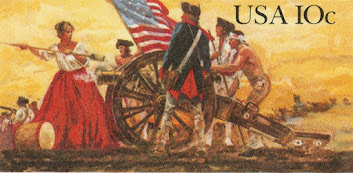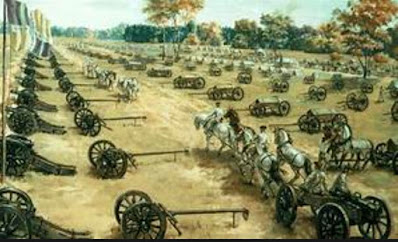#104 FOUR BROTHERS--BAXTER HOWE, CASUALTY
Anna and Bezaleel How’s four sons--Timothy, Darius, Baxter and Bezaleel, all served in the American Revolution. I have used the book Four Brothers in the American Revolution by Herbert Howe as my source for the How biographies.
BAXTER HOWE
Baxter Howe was born August 29, 1748 in Rutland, Massachusetts, third son of Bezaleel and
Anna. He was just four years old when his father died and his widowed mother
brought him back to his grandmother’s care. At age nine, he and his younger brother
were placed in an uncle’s care. The uncle was very patriotic and a real task master.
The boys worked hard for their bread and board, received little schooling. They
stayed there for 12 years until, in 1769, they were reunited in Hillsborough, New
Hampshire with their mother and sister. While the younger son harboured resentment
towards his mother for abandoning him, it seems that Baxter developed a more
positive outlook on life. He quickly integrated into town life, became involved in
community and church affairs, and operated a public tavern that served as the
centre of civic gatherings. He was a respected young man, known for his energy,
intelligence, and good nature. These were, obviously, the qualities that would later earn his rapid promotions in the military.
In 1773,
Baxter, aged 25, married Levinia Taylor; they had one son named Brigham.
As did all colonists, Baxter learned rudimentary soldiering with the Hillsborough militia. He quickly responded when he heard the April 1775 news from Lexington.
But before he left for war, he took Lavinia and his young son to her mother’s, believing his wife would be more comfortable there in his absence. In hindsight, this was a good move as Lavinia succumbed to a fatal illness and died in December 1775; baby Brigham grew up in his grandmother’s care.
The Continental Army
Baxter became one of the first soldiers of the Continental Army. He had joined the 21st Continental Regiment, a Massachusetts militia unit; this unit merged with the newly-formed Continental Army which was created in June 14, 1775 to coordinate the colonies' war against Britain. (There were Americans who held to the importance of volunteer state militias and thus were adverse to maintaining a standing army, but most felt the colonies required the discipline and organization of a central army.) George Washington served as its commander-in-in-chief throughout the war without any compensation.
Soldiers of the Continental Army had no formal military experience, no uniforms, no established regiments or commanders, only limited firearms and no allies.. The British, on the other hand, had an established, well-trained and disciplined army, with ample supplies of powder, guns and clothing. The Continental Army was the obvious underdog but its soldiers did know the terrain and could use this knowledge for defensive tactics. Soldiers of the Continental Army came from all walks of life, volunteers who enlisted for one year (later extended to three years.) When established in 1775, soldiers had no uniforms. Brown was to be the official uniform colour, but a shortage of such cloth meant some regiments, in a effort to have consistency. used grey or blue. The absence of uniforms caused problems as soldiers were not able to easily distinguish their officers on the battlefield so the decision was made to use different-colour cockades to indicate an officer's rank. (Field Officers: pink or red. Captains: buff or yellow. Junior Officers; green. Then leaders adopted the black cockade)
Weapons used by the Continental Army included muskets, pistols, rifles, knives, bayonets, tomahawks, axes, sabres, pole arms and cannons. The most popular weapon was the Brown Bess, a flintlock musket, usually with a bayonet. It had a short range and was not very accurate; only about 20% of the lead hit the target.
Against all odds, the Continental Army achieved victor over the British. It fought in 36 major Revolutionary battles plus almost 100 lesser battles. A total of 35,000 soldiers served in the Continental Army, backed by 44,500 militia. About 25,000 soldiers who served in the Continental Army died-8,000 died in battle and 17,000 died of disease or went missing in action. Another 9,000 soldiers were injured.
Highlights of Baxter’s military career
Baxter fought with the Continental Army from the first days of the American Revolution through to its final decisive campaigns; he participated in almost every northern theatre, endured brutal winters, dangerous engagements and personal tragedy. In some of the engagements, he was united with two of his brothers. Baxter’s diary, with his reflections of the war, survived into the late 19th century. It gave a chronology of engagements. Unfortunately, these paper have been lost.
Battle of Bunker Hill (June 17, 1775) -joined the 32 Massachusetts Regiment -earned first promotion to sergeant.
Siege of Boston (April-March 1776) -present with his regiment during this prolonged standoff.
Promoted to
Second Lieutenant (Jan 1776) then First Lieutenant. His pay now was $33.33 a
month (+ subsistence pay of $10), later
raised to $50.
Battle of Long Island (August 1776) -participated in this disastrous American defeat with his brothers, Darius and Bezaleel. - possibly captured and exchanged.
Retreat through New York and New Jersey (late 1776) including the battles and marches that followed the Long Island defeat.
Baxter transferred
to Second Continental Artillery
Battle of Trenton (December 26, 1776) -most likely he was with Washington when he covertly crossed the Delaware River -likely participated in Washington’s counterattack
Battle of Trenton
Battle of
Princeton (January 3, 1776)
Valley Forge Encampment (1777-1778) -wintered here with his brothers and endured hunger, disease and despair.
Battle of Monmouth (June 1778) -distinguished himself in this major battle
White
Plains and Middlebrook Encampments (1778) Stationed here between battles
Baxter promoted to
Captain-Lieutenant (November 7, 1778)
Mary Moore
was the daughter of a New York refugee family. (Many colonists left that city
when the British took it.) Baxter and Mary met at an officer social, they
became good friends and were married on May 15, 1779. George Washington attended their wedding
breakfast.
Three
months after the wedding, Baxter’s detachment was ordered to join the Sullivan-Clinton
Expedition.
Sullivan-Clinton Expedition (Summer 1779) The Sullivan-Clinton Expedition from June to October 1779 was a major campaign aimed at weakening the Iroquois Confederacy, many of whose nations had allied with the British. Ordered by General George Washington, the American force marched through present-day Pennsylvania and New York, destroying more than 40 Iroquois villages, crops, and food stores. The campaign was in retaliation for earlier attacks on American frontier settlements, such as the Wyoming (from where Baxter's older brother and family had escaped) and Cherry Valley massacres, and to prevent further raids on the American frontier. Though it faced little direct military resistance, the expedition devastated the Iroquois homeland, leading to mass displacement and starvation among the Native population. The operation effectively broke the Iroquois Confederacy's military power for the remainder of the war. It was written (by Baxter?)“The army took up the line of its march into an unknown country, through leagues of unbroken forest, into the very heart of the enemy’s territory, relying on its own valour alone for success, without hope of relief or reinforcements, or, in the case of defeat, of any quarter. An expedition—without scarcely a parallel—for the boldness of its design and the courage with which it was undertaken. To transport an army with its equipment and supplies, through an uncivilized country without roads, for much of the way without water communication, to cut loose from their base—to be shut up for weeks from the intelligence of the world, where to fall was to die, and ordinarily to die by torture, was an example of heroic bravery.”
The war, was at a standstill. In April 1781, Washington decided to send detachments south to fight the British at Yorktown, Virginia. Captain-Lieutenant Baxter Howe’s battery was sent as an advance detachment. There were skirmishes along the way. The march south was punishing—30 miles a day. They were short of supplies, campsites were often in swamps, the food was inadequate and the water frequently contaminated. Fevers spread. Weakened by over-exertion, Baxter’s health deteriorated—he most likely died of disease worsened by hardship and malnutrition.
Captain-Lieutenant Baxter Howe, aged 33, died on September 20, 1781, just weeks before the decisive victory at Yorktown. He was buried in an unmarked grave somewhere near Eutaw Springs, South Carolina or the James River below Williamsburg, Virginia.
Baxter was survived by his second wife, Mary, and their daughter and a son. His widow moved back to her hometown of New York City. Their daughter, Elizabeth, was just six months old when her father died. (Hers is a story for another blog.) As a survivor of an officer of the 2nd Continental Artillery, a New York Regiment, Mary was granted a military bounty of 1000 acres in Cayuga County, New York. Though her husband died in the war, she did not, however, receive a pension. Mary died in New York on March 16, 1819, aged 71.
Son Brigham, by Baxter’s first marriage, lived with his maternal grandmother until he was fourteen. At that time, he was sent to New York City where his paternal uncle Bezaleel wished to “make him a man of business”. The boy was told to be “decently clothed” and to “behave well and be warned of the many snares and temptations that youth are exposed to.” Brigham became a successful grocer. He and his uncle became close friends and both joined the Society of the Cincinnati--uncle Bazeleel as an original member and Brigham as the son of an officer who had died in service.
BAXTER HOWE b. Aug 29, 1748 in Rutland, Massachusetts m. Lavinia Taylor (1749-1775) on Sept 22, 1773 in Southborough, Mass. m. Mary Moore (1748-1819) on May 15,1779 in Bound Brook, New Jersey d. Sept 20, 1781 in Virginia or South Carolina my 2nd cousin 7x removed (Netterfield-Farnum line)



















Comments
Post a Comment